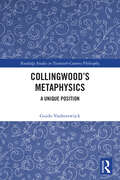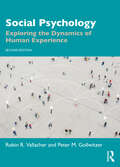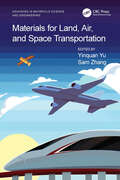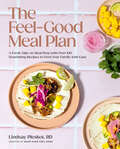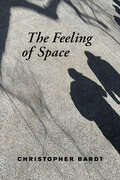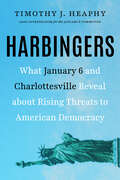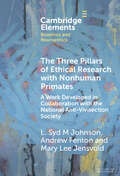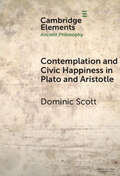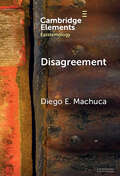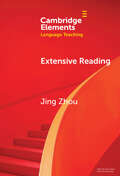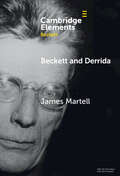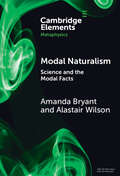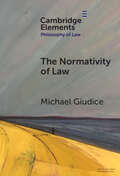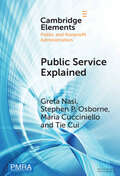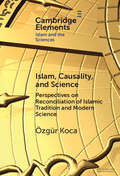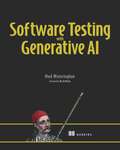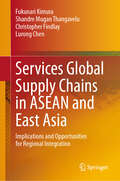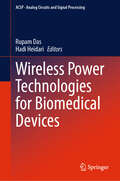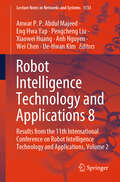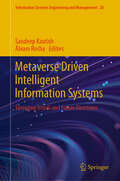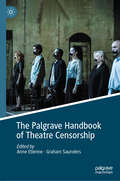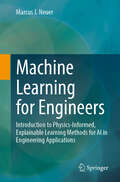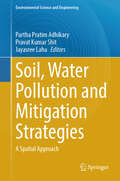- Table View
- List View
Collingwood’s Metaphysics: A Unique Position (Routledge Studies in Twentieth-Century Philosophy)
by Guido VanheeswijckThis book explores R.G. Collingwood’s concept of metaphysics. It traces the evolution of Collingwood’s thought on metaphysics through his published work, posthumously published manuscripts and recently discovered course notes.From 1933 to 1936, Collingwood’s thought shifted considerably from the more orthodox Hegelian treatment of metaphysics as the study of the general nature of reality to the more ‘historicist’ study of absolute presuppositions. This radical conversion hypothesis has been for a long time the single most important issue in the interpretation of Collingwood’s philosophy. This book provides a fresh reappraisal of his thinking on metaphysics during these crucial years. It argues that objective idealism is the key to unraveling the true scope of Collingwood’s metaphysics. This theory takes a mid- position between mainstream interpretations in the secondary literature and forms the background to many of Collingwood’s key ideas regarding metaphysics, the philosophy of nature and the philosophy of history. The book also compares Collingwood’s concept of metaphysics to that of his predecessors, contemporaries and followers. The second part of the book focuses in detail on the similarities and differences between Collingwood’s metaphysics and, in chronological order, the views on metaphysics of Dilthey, Whitehead, Ayer, Wittgenstein, Heidegger, Berlin, Kołakowski, Strawson and Taylor.Collingwood’s Metaphysics will be of interest to scholars and graduate students interested in Collingwood’s philosophy, 20th- century philosophy and metaphysics.
Social Psychology: Exploring the Dynamics of Human Experience
by Robin R. Vallacher Peter M. GollwitzerThis topical textbook provides a thorough insight into the discipline of social psychology, presenting students with a rich and engaging account of the human social experience.Fully revised, the second edition includes a greater emphasis on cutting-edge topics within social psychology, including AI, virtual reality, social media, and political polarization. The textbook uses an accessible and readable style to show how the field’s dizzying and highly fragmented array of topics, models, theories, and paradigms can best be understood through a coherent conceptual narrative that builds on learning from previous chapters. The text also examines recent developments, such as how computer simulations and big data supplement the traditional methods of experiment and correlation. It contains a range of features, including key term glossaries and compact “summing up and looking ahead” overviews for ease of reading.Social Psychology: Exploring the Dynamics of Human Experience covers an enormous range of topics from self-concept to social change, making this comprehensive textbook essential reading for any student of social psychology.
Materials for Land, Air, and Space Transportation (Advances in Materials Science and Engineering)
by Sam Zhang Yinquan YuAs transportation systems for land, air, and space vehicles continue to grow increasingly sophisticated, more advanced materials are needed to support their development and commercialization. Materials for Land, Air, and Space Transportation details new materials development for these transportation applications, emphasizing physical properties, research theories, and cutting-edge processing technologies, as well as advanced high-precision inspection methodologies.• Covers materials, design, and manufacturing for lightweight vehicles, high-speed trains, fuel cell vehicles, and aerospace and aeronautical use.• Focuses on the newest material function and processing technologies, covering nanotechnology, modern additive manufacturing techniques, and physical and mechanical studies of structure-sensitive properties of materials.• Describes theoretical deduction, numerical simulation, and experimental studies of various materials.This reference will be of interest to engineers and researchers in the disciplines of materials, mechanical, and transportation engineering, and related areas.
The Feel-Good Meal Plan: A Fresh Take on Meal Prep with Over 100 Nourishing Recipes to Feed Your Family with Ease
by Lindsay PleskotFlexible meal planning for your busy life! With weekly meal prep done in under two hours, you&’ll have flavorful, nutrition-packed meals on the table quickly every night of the week.You lead a busy life and it can be tough to find the time and energy to make nourishing, flavorful meals every morning, afternoon, and night. Maybe you tried meal prepping and it zapped all the joy out of eating. Was it the rigidity? The repetitive meals day after day? The hours of work? Don&’t give up: The Feel-Good Meal Plan has a fresh, flexible, and unfussy solution to get you ready for the week—with less than two hours of prep and meals on the table every night in 30 minutes or less. With Registered Dietitian and mom of two Lindsay Pleskot as your guide, take the next steps on your meal-planning journey with: A Four-Week Meal Plan: Dive into a month of lunches and dinners designed to save time, minimize food waste, and maximize taste and nutrition. Follow ready-made grocery lists and step-by-step meal prep instructions to simplify the process. Affordable, Accessible Cooking: No fancy ingredients required— just everyday staples you likely already have on hand. These recipes and shopping tips will keep your grocery bill and food waste to a minimum. 100+ Family-Friendly Recipes: Try breakfasts like One-Pan Green Goddess Hash and Tiramisu Overnight Oats, snacks like Chocolate Chip Cookie Dough Energy Bites and Mexican Street Corn–Inspired Guacamole, and heaps of mains, like Korean- Inspired Beef and Rice Bowls with Pickled Cukes, Sheet Pan Margarita Shrimp Fajitas, Best-Ever Veggie Bolognese, and Juicy Spinach and Feta Turkey Burgers. Healthful, Intuitive Eating: Drawing on her certification as an Intuitive Eating Counselor, Lindsay has crafted meal plans and recipes that foster a balanced and joyful relationship with food, nurturing body, mind, and soul. Ideal for busy families looking to alleviate the daily cooking grind, The Feel-Good Meal Plan gives you the freedom to enjoy mealtimes with ease!
The Feeling of Space
by Christopher BardtA richly illustrated exploration of humanity’s drive to shape life as a spatial project, from Plato’s time to the digital era.Place is something real, but space is generally conceived as abstract and immaterial. In The Feeling of Space, Christopher Bardt explores this damaging modern binary and traces the contradictory impulses that have dematerialized our sense of space through history: fear and wonder; a yearning for the infinite and intimate; and the need for autonomy and belonging. Using rich illustrations and examinations of art, technology, and philosophy, Bardt argues that if we can get back to first feeling space, then we can treat space as the substance that gives agency to our intersubjectivity—the exchange of conscious and unconscious thoughts we have with others. Expertly connecting ideas with clear examples from lived experiences, Bardt’s revolutionary framework will appeal to a broad readership, particularly those who are interested in the theoretical and philosophical aspects of spaces. In an age where digital media has dissolved, instead of increased, our sense of connection, The Feeling of Space shows that when we learn to experience space as a medium as real as a place, we not only see ourselves as inherently spatialized beings, but we can also rebuild the bonds that tie us together.
Harbingers: What January 6 and Charlottesville Reveal About Rising Threats to American Democracy
by Timothy J. HeaphyA clear-eyed assessment of where we go from here—detailing how to combat misinformation and isolation—from the foremost expert on American political violence&“A soulful and significant contribution to defeating the authoritarian threat in America.&” — Congressman Jamie Raskin, author of Unthinkable: Trauma, Truth, and the Trials of American Democracy&“Tim&’s insights can help us reclaim a government that works for all Americans and restore faith in our democratic institutions.&” — Barbara McQuade, author of Attack from Within: How Disinformation is Sabotaging AmericaAs the lead investigator into both the 2017 racist riot in Charlottesville and the January 6 insurrection, Tim Heaphy has a unique perspective on the cynicism and anger that also fueled Trump&’s return to the Presidency. All 3 events, both the violent protests and the peaceful and lawful decisions made at the ballot box in November of 2024, reflect an increasing lack of trust in institutions among a growing number of Americans.In his page-turning book, Heaphy shares what he saw and came to understand about what those events say about the state of American democracy. He examines how and why they took place with the hope that understanding the contexts of these events will be a crucial and helpful step toward avoiding similar episodes of political violence in the years ahead.Readers will travel alongside Heaphy as he organized his team and structured the massive investigations they were about to undertake, as he interacts with politicians and members of law enforcement, interviews planners, perpetrators, and bystanders, gathers and sorts evidence, and compels and records testimony in order to create a record for today as well as future generations.
The Three Pillars of Ethical Research with Nonhuman Primates: A Work Developed in Collaboration with the National Anti-Vivisection Society (Elements in Bioethics and Neuroethics)
by L. Syd Johnson Andrew Fenton Mary Lee JensvoldThe Three Pillars (Harmonization, Replacement, and Justice) describe an ethical path forward and away from the use of nonhuman primates in harmful research and scientific use. Conducting nonhuman primate research in an ethical way that acknowledges their moral importance requires satisfying more rigorous guidelines and regulations modeled on those that apply to similarly vulnerable human subjects, especially children and incarcerated persons. This Element argues for the moral necessity of harmonizing human and nonhuman primate research ethics, regulations, and guidelines in a way that protects all primates, human and nonhuman. The authors call for the replacement of nonhuman primates in research with human-relevant methods that do not simply shift research onto other nonhuman animals, and challenge publics, governments, and scientific communities worldwide to implement justice in the selection and use of all research subjects. This title is also available as Open Access on Cambridge Core.
Contemplation and Society in Plato and Aristotle (Elements in Ancient Philosophy)
by Dominic ScottThis Element concerns the civic value of contemplation in Plato and Aristotle: how does intellectual contemplation contribute to the happiness of the ideal state? The texts discussed include the Republic, the Nicomachean Ethics and the Politics, works in which contemplation is viewed from a political angle. The Element concludes that in the Republic contemplation has purely instrumental value, whereas in the Politics and Nicomachean Ethics it has purely intrinsic value. To do justice to the complexity of the issues involved, the author addresses a broader question about the nature of civic happiness: whether it is merely the aggregate of individual happiness or an organic quality that arises from the structure of the state. Answering this question has implications for how contemplation contributes to civic happiness. The Element also discusses how many citizens Plato and Aristotle expected to be engaged in contemplation in the ideal state.
Disagreement (Elements in Epistemology)
by Diego E. MachucaThis Element engages with the epistemic significance of disagreement, focusing on its skeptical implications. It examines various types of disagreement-motivated skepticism in ancient philosophy, ethics, philosophy of religion, and general epistemology. In each case, it favors suspension of judgment as the seemingly appropriate response to the realization of disagreement. One main line of argument pursued in the Element is that, since in real-life disputes we have limited or inaccurate information about both our own epistemic standing and the epistemic standing of our dissenters, personal information and self-trust can rarely function as symmetry breakers in favor of our own views.
Extensive Reading (Elements in Language Teaching)
by Jing ZhouThis Element focuses on extensive reading (ER), a language learning and teaching approach that encourages language learners to read a large amount of interesting and level-appropriate reading materials. Extensive reading has been adopted across educational spectrums, including higher, secondary, and elementary levels, and implemented in diverse language contexts such as English, Chinese, Italian, Spanish, and French. The primary objective of this Element is to offer comprehensive insights into the theoretical foundations of ER, analyze its multifaceted benefits to language learning, address the challenges encountered in its implementation, and propose effective strategies drawn from research for these challenges. The Element concludes with an overview of the latest trends and developments in ER.
Beckett and Derrida (Elements in Beckett Studies)
by James MartellUncannily similar projects, Beckett's and Derrida's oeuvres have been linked by literary and philosophy scholars since the 1990s. Taking into consideration their shared historical and personal contexts as writers whose main language of expression was 'adopted' or 'imposed', this Element proposes a systematic reading of their main points of connection. Focusing on their engagement with the intricacies of beginnings and origins, on genetic grounds or surfaces analogous to the Platonic khôra, and on their similar critiques of the aporias of sovereignty, it exposes the reasons why multiple readers, like Coetzee, consider Derridean deconstruction a philosophical mirror of Beckett's literary achievements.
Modal Naturalism: Science and the Modal Facts (Elements in Metaphysics)
by Amanda Bryant Alastair WilsonHow do we know what is possible or impossible, what is inevitable or unattainable, or what would happen under which circumstances? Since modal facts seem distinctively mysterious and difficult to know, the epistemology of modality has historically been fraught with uncertainty and disagreement. The recent literature has been dominated by rationalist approaches that emphasise a priori reasoning (sometimes including direct intuition of possibility). Only recently have alternative approaches emerged which recognize a broader range of sources of modal knowledge. Yet even emerging non-rationalist views have tended to assign scientific investigation at best a supporting role. Our project in this book is to develop and defend a new approach to the epistemology of modal facts which assigns a central role to scientific investigation. According to modal naturalism, science (construed broadly) is our primary source of evidence concerning the modal facts.
The Normativity of Law (Elements in Philosophy of Law)
by Michael GiudiceIn the philosophy of law there has been a proliferation of advanced work in the last thirty years on the normativity of law. Recent theories explore law's character as a special kind of convention, shared cooperative activity, and social artifact, among other perspectives, to explain the precise way in which law provides subjects with reasons for action. Yet, for all their sophistication, such accounts fail to deliver on their promise, which is to establish how law creates more than just legal reasons for action. This Element aims to survey these views and others, situate them in a broader context of theories about the nature of law, and subsequently suggest a path forward based on the methodological continuity between analytical, evaluative, and empirical approaches to law's normativity.
Public Service Explained: The Role of Citizens in Value Creation (Elements in Public and Nonprofit Administration)
by Greta Nasi Stephen Osborne Maria Cucciniello Tie CuiThis Cambridge Element aims to advance theory by investigating the nature of participation in public service delivery. It situates itself under the theory of Public Service Logic to advocate for a strategic orientation to participation as an element of value creation in public services. It introduces the concept of participation and discusses the motives, incentives, and tools to engage citizens in public service delivery processes. Then, it frames citizens' participation under the approach public service ecosystem to capture the dynamic relationships among citizens, other actors, processes, and structures that may contribute to determining value in public service delivery. It presents the dynamics of value creation and destruction in public service. The Element concludes with implications for research and practice. This title is also available as Open Access on Cambridge Core.
Islam, Causality, and Science: Perspectives on Reconciliation of Islamic Tradition and Modern Science (Elements in Islam and Science)
by Özgür KocaThis Element intends to contribute to the debate between Islam and science. It focuses on one of the most challenging issues in the modern discussion on the reconciliation of religious and scientific claims about the world, which is to think about divine causality without undermining the rigor and efficacy of the scientific method. First, the Element examines major Islamic accounts of causality. Then, it provides a brief overview of contemporary debates on the issue and identifies both scientific and theological challenges. It argues that any proposed Islamic account of causality for the task of reconciliation should be able to preserve scientific rigor without imposing a priori limits on scientific research, account for miracles without turning them into science-stoppers or metaphors, secure divine and creaturely freedom, and establish a strong sense of divine presence in the world. Following sections discuss strengths and weaknesses of each account in addressing these challenges.
Software Testing with Generative AI
by Mark WinteringhamSpeed up your testing and deliver exceptional product quality with the power of AI tools.The more you test, the more you learn about your software. Software Testing with Generative AI shows you how you can expand, automate, and enhance your testing with Large Language Model (LLM)-based AI. Your team will soon be delivering higher quality tests, all in less time. In Software Testing with Generative AI you&’ll learn how to: • Spot opportunities to improve test quality with AI • Construct test automation with the support of AI tools • Formulate new ideas during exploratory testing using AI tools • Use AI tools to aid the design process of new features • Improve the testability of a context with the help of AI tools • Maximize your output with prompt engineering • Create custom LLMs for your business&’s specific needs Software Testing with Generative AI is full of hype-free advice for supporting your software testing with AI. In it, you&’ll find strategies from bestselling author Mark Winteringham to generate synthetic testing data, implement automation, and even augment and improve your test design with AI. Foreword by Nicola Martin. About the technology There&’s a simple rule in software testing: the more you test, the more you learn. And as any testing pro will tell you, good testing takes time. By integrating large language models (LLMs) and generative AI into your process, you can dramatically automate and enhance testing, improve quality and coverage, and deliver more meaningful results. About the book Software Testing with Generative AI shows you how AI can elevate every aspect of testing—automation, test data management, test scripting, exploratory testing, and more! Learn how to use AI coding tools like Copilot to guide test-driven development, get relevant feedback about your applications from ChatGPT, and use the OpenAI API to integrate AI into your data generation. You&’ll soon have higher-quality testing that takes up less of your time. What's inside • Improve test quality and coverage • AI-powered test automation • Build agents that act as testing assistants About the reader For developers, testers, and quality engineers. About the author Mark Winteringham is an experienced software tester who teaches many aspects of software testing. He is the author of Testing Web APIs. The technical editor on this book was Robert Walsh. Table of Contents Part 1 1 Enhancing testing with large language models 2 Large language models and prompt engineering 3 Artificial intelligence, automation, and testing Part 2 4 AI-assisted testing for developers 5 Test planning with AI support 6 Rapid data creation using AI 7 Accelerating and improving UI automation using AI 8 Assisting exploratory testing with artificial intelligence 9 AI agents as testing assistants Part 3 10 Introducing customized LLMs 11 Contextualizing prompts with retrieval-augmented generation 12 Fine-tuning LLMs with business domain knowledge Appendix A Setting up and using ChatGPT Appendix B Setting up and using GitHub Copilot Appendix C Exploratory testing notes
Services Global Supply Chains in ASEAN and East Asia: Implications and Opportunities for Regional Integration
by Fukunari Kimura Lurong Chen Christopher Findlay Shandre Mugan ThangaveluThe book provides the analytical framework as well empirical analysis of the development of services GVC in the ASEAN and East Asian region. This book provides extensive discussions at both regional level and respective country level development of services GVC activities. This book highlights discussions on the developments in services and structural transformation and regional development of services liberalization and alignment to the GVC in the ASEAN Member states as well as the East Asian countries of Australia, China, India, Japan, and Korea. The studies in this book also covers key and specific services development in terms of tourism, business services, logistics, heath, aviation, accounting, finance and insurance, BPO services, wholesale and retail, knowledge-based services using the GVC framework.This book focuses on the development of services from a supply chain perspective and a deeper assessment of the implications for the policy coverage and design ofregional integration related to services. This book explores key issues related to migration, movement of people, digital trade, and skills development in the ASEAN countries to adapt to the new dimensions of the GVC activities in the region. This book presents 15 chapters with an overview chapter, country-specific chapters covering 13 ASEAN and East Asian countries and a policy discussion chapter.
Wireless Power Technologies for Biomedical Devices (Analog Circuits and Signal Processing)
by Hadi Heidari Rupam DasDiscover ground-breaking advancements in wireless biomedical device technology with our comprehensive book, which delves into the latest innovations revolutionizing Healthcare Chapter 1 introduces wireless power transfer (WPT) techniques, offering a solution to the frequent battery replacements required by cardiovascular implantable medical devices (cIMDs). Explore how WPT holds the promise of long-term functionality for these life-saving devices, ushering in an era of more efficient and convenient healthcare solutions. In Chapter 2, explore the world of energy harvesting for cardiovascular implants. From Triboelectric Nanogenerators (TENG) to Biofuel cells, discover how self-powering devices are reshaping the landscape of cardiovascular healthcare, reducing the need for battery replacements, and enhancing patient convenience. Chapter 3 unveils the potential of magnetoelectric composites in wireless power transfer for biomedical applications, while Chapter 4 sheds light on the competency of Triboelectric Nanogenerators in wireless device applications, offering a sustainable alternative to traditional batteries. Chapter 5 showcases the promise of photovoltaic energy scavenging for implantable medical devices, highlighting its potential to revolutionize healthcare with higher-power conversion efficiencies and smaller form factors. Explore the realm of ultrasound-based wireless powering technologies in Chapter 6, offering insights into the physics of acoustic powering and the design considerations for ultrasonically powered devices. Chapter 7 ventures into the realm of smart contact lenses, discussing their transformative potential in healthcare, augmented reality, and personalized computing. In Chapter 8, dive into the research gap for Single Input, Single-Output (SISO) state-of-the-art biomedical devices, exploring the challenges and opportunities in charge pump converters and multi-output converters. Finally, Chapter 9 explores power management integrated circuits for implantable devices, focusing on energy efficiency and optimal power usage to prolong device life and minimize power loss. With contributions from leading experts in the field, this book is an indispensable resource for researchers, engineers, and healthcare professionals alike, shaping the future of implantable medical devices and advancing patient care worldwide.
Robot Intelligence Technology and Applications 8: Results from the 11th International Conference on Robot Intelligence Technology and Applications, Volume 2 (Lecture Notes in Networks and Systems #1133)
by Wei Chen Anwar P. P. Abdul Majeed Pengcheng Liu Xiaowei Huang Anh Nguyen Eng Hwa Yap Ue-Hwan KimThis book dives into the vanguard of robotics and AI with this scholarly edition, a compilation of pioneering research from the 11th International Conference on Robot Intelligence Technology and Applications (RiTA) Volume 2. This book focuses on ‘Machine Learning and AI Applications’, which elucidates the transformative power of contemporary AI across a multitude of domains, from medical diagnostics to natural language comprehension. This book uncovers innovative models, avant-garde training techniques and sophisticated interpretability methods that underscore the versatility and robustness of AI. This book is an indispensable asset for researchers and practitioners navigating the digital frontier.
The Making of the Modern Organisation: From the First to the Fourth Industrial Revolution
by Paul TurnerThe Fourth Industrial Revolution will transform the global competitive landscape and as such require a radical response from organisations operating in complex, knowledge-based economies. Much like previous phases of economic, social and technological changes, there is an assumption that existing technologies will become obsolete and alternative sources of value creation must be found. These assumptions will create significant opportunities in the next revolutionary cycle, but to take advantage of these will require a new business model and organisational constructs. In charting the course of structures and dynamics over the first Three Industrial Revolutions, this book offers points of learning that can be applied to the Fourth. It offers a discussion about how organisations have emerged over time and how they learnt to adapt to industrial revolution and economic upheaval. Covering conceptual ideas about organisations as collections of individuals, the book will also highlight the practice of organisation from the First to the Fourth Industrial Revolution with examples across Europe the USA and Asia. Building on the ideas and concepts in The Making of the Modern Manager, this book explores the changing business contexts through industrial revolutions, the practice of organisation in response to these changes, the theory of organisation and the definition of organisation
Metaverse Driven Intelligent Information Systems: Emerging Trends and Future Directions (Information Systems Engineering and Management #20)
by Álvaro Rocha Sandeep KautishThe Metaverse has revolutionized the landscape of designing and implementing modern information systems by introducing a new dimension of connectivity and interaction. Information systems, traditionally confined to desktop applications and web platforms, have now expanded into immersive virtual spaces, blurring the lines between the physical and digital worlds. This shift has led to the integration of real-time data sharing, collaboration, and communication within the Metaverse, enhancing user experiences and data accessibility. Metaverse driven Intelligent Information Systems embodies knowledge based behavior which enables them to act intelligently and interact with end users & other systems in the process of solving variety of problems i.e. classification, retrieval, discovery and manipulation of hidden patterns and useful insights of data which leads to decision making process. IIS also deals with fetching, classifying, retrieving, and storing multimedia data for creating intelligent visual user interfaces for enhanced user experiences. This book presents fresh ideas and latest advances in the field of Intelligent Information Systems powered by Metaverse and related applications in the different areas i.e. optimization of complex systems, medical diagnosis, robotics and automation, and time series predictions. The proposed book is intended for readers i.e. researchers and professors in the field of computer science working on various new directions and aspects of intelligent information systems and machine intelligence. Distinguished Features of the proposed book – State-of-art documentation of Metaverse driven Intelligent Information Systems and their applications right from beginner level to advanced level. Excellent reference material for academic scientists, researcher and research scholars working in modern information systems domain. This book will showcase the recent innovations, trends, and concerns as well as applied challenges encountered and solutions adopted in the fields of Metaverse and Information Systems design and development.
The Palgrave Handbook of Theatre Censorship
by Graham Saunders Anne EtienneThis book incorporates a wide theoretical, cultural, literary and historical engagement in exploring the tension between dramatic productions and the forms of censorship they encounter from creation to reception. The Palgrave Handbook of Theatre Censorship offers global new insights into censorship practices, examining attempts at repression motivated either by fears that audiences gathering together to watch live dramatic events will lead to sedition and mass uprisings, or by moral or religious squeamishness requiring the establishment of institutional systems of censorship to curb or suppress the stage. As such, the Handbook aims to initiate redefinitions of what we understand or experience as censorship. Who knew theatre could (still) carry so many threats, or be so widely provocative and dangerous? This is an extraordinary and often eye-opening set of thirty-six individually insightful, wide-ranging and oftentimes disturbing essays, each of which offers unique insights into theatre censorship practices and their impact within a specific political and moral culture. There is a particular emphasis on the recent and current, and the authors speak with first-hand knowledge and from direct experience not only about the restrictions but also how artists sometimes negotiate and evade these. What makes the book so especially fascinating and illuminating is seeing so many examples juxtaposed together. This enables the reader to hear the essays and the cultures talking to and alongside each other. The collection repeatedly breaks fresh ground, and the editors deserve enormous credit for gathering and effectively curating so many reports from the front-line. Steve Nicholson, Emeritus Professor, University of Sheffield, UK Anne Etienne and Graham Saunders’s book is a wide-ranging, incisive and compelling collection of reflections and case studies on the theatre industry’s relationship to censorship and self-censorship from a historical and contemporaneous perspective. An impressive array of authors have been assembled for this volume representing, among them, views on the subject from Spain, Denmark, Norway, Zimbabwe, South Africa, Germany, Italy, Indonesia, Iran, Portugal, Turkey, Brazil, Japan, Ireland, Australia, Russia, England and more. The book is by turns surprising in its curatorial and narrative design and wonderfully effective at delineating the complex and thorny paths that create socio-political cultures where the censorship and self-censorship of theatre artists thrives and/or is efficaciously contested and rebelled against. Of note is a through line of argument in the book around less overt modes of surveillance that police artists’ imaginations and thereby the work they create and produce. At a time in the world where many governments are increasingly seeking to limit artistic expression, this book is a necessary reminder of the many freedoms that have been fought for in theatres around the globe, and how the power of being unsilenced must never be taken for granted. – Caridad Svich. Playwright & Translator This is a truly excellent collection of incisive studies. It is wide-ranging, impressively global in scope, with an illuminating balance of the historical and the contemporary. In its impressive and well-realised ambition, demonstrated by the well-focused intelligence and academic flair of its many contributors, this collection is both magisterial and vital. It is an essential contribution to censorship studies, fascinating and inspiring, a must-read for anyone interested in the subject. – Aleks Sierz. Theatre critic and author of Rewriting the Nation: British Theatre Today (2011) & Good Nights Out: A History of British Theatre Since the Second World War (2021)
Machine Learning for Engineers: Introduction to Physics-Informed, Explainable Learning Methods for AI in Engineering Applications
by Marcus J. NeuerMachine learning and artificial intelligence are ubiquitous terms for improving technical processes. However, practical implementation in real-world problems is often difficult and complex. This textbook explains learning methods based on analytical concepts in conjunction with complete programming examples in Python, always referring to real technical application scenarios. It demonstrates the use of physics-informed learning strategies, the incorporation of uncertainty into modeling, and the development of explainable, trustworthy artificial intelligence with the help of specialized databases. Therefore, this textbook is aimed at students of engineering, natural science, medicine, and business administration as well as practitioners from industry (especially data scientists), developers of expert databases, and software developers.
Soil, Water Pollution and Mitigation Strategies: A Spatial Approach (Environmental Science and Engineering)
by Pravat Kumar Shit Partha Pratim Adhikary Jayasree LahaDive into the dynamic world of environmental stewardship with "Soil, Water Pollution, and Mitigation Strategies: A Spatial Approach." This meticulously crafted volume offers a comprehensive journey through the measurement, monitoring, mapping, and modelling of soil and water pollution, coupled with innovative mitigation strategies. Discover cutting-edge techniques rooted in modern geospatial methodologies, with a sharp focus on the latest trends in data mining and robust modelling. As our planet grapples with the consequences of anthropogenic activities, such as indiscriminate chemical usage in agriculture, the need for precise quantification and risk assessment has never been more urgent. This book serves as a beacon, illuminating the path toward sustainable management of soil and water resources through the lens of geospatial technology. Explore a myriad of critical topics, including soil microbiology, salinity, pollution from industrial sources, heavy metals, and the pervasive impact of agricultural practices. Delve into environmental risk assessment, sustainable land use, and innovative remediation techniques, such as harnessing the power of Plant Growth-Promoting Rhizobacteria (PGPR) and embracing organic fertilizers. Written for researchers, professionals, and policymakers alike, this book offers invaluable insights into the complex interplay between human activity and environmental health. Organized into two parts (I) Soil Contaminants, Risk Assessment, and Mitigation, and (II) Water Contaminants, Risk Assessment, and Mitigation—it provides a structured approach to understanding and addressing environmental challenges. Each chapter serves as a portal to a deeper understanding of the issues at hand, presenting a synthesis of current research, identifying future directions, and offering pragmatic solutions. This book promises to enrich the understanding of environmental science and empower the reader with the knowledge and skills needed to effect positive change. Designed to cater to a diverse audience—from students and researchers in environmental sciences to policymakers, NGOs, and corporate stakeholders—this book is a testament to the collaborative effort required to safeguard our planet's precious resources. This is a transformative journey toward a more sustainable future—one informed by science, guided by innovation, and driven by a shared commitment to environmental stewardship.
Handbook of Early Intervention for Autism Spectrum Disorders: Research, Policy, and Practice (Autism and Child Psychopathology Series)
by Johnny L. Matson Peter Sturmey Dennis R. DixonThe Second Edition of this handbook provides significantly updated and expanded content and coverage, including new chapters on the changing epidemiology of autism spectrum disorder (ASD), measurement and assessment of problem behaviors, value-based care for ASD, conceptual foundations of evidence-based practices, the use of technology, and functional behavior assessment in ASD treatment. This unique volume addresses basic questions in salient detail, from epidemiology and diagnosis to guiding treatment decisions. In addition, it examines treatment delivery systems and new technologies to support individuals with ASD. Key areas of coverage include: History of the evolving diagnostic criteria for ASD. Early screening and diagnostic measures and practices. Ethics and economics of early intervention. Detailed descriptions of evidence-based practices in treating the behavioral deficits and excesses associated withASD. Interdisciplinary collaboration to address co-occurring conditions and treat the whole patient. Caregiver collaboration to foster treatment integrity and consistency to improve outcomes. The Second Edition of the Handbook of Early Intervention for Autism Spectrum Disorders is a must-have comprehensive reference for researchers, professors, and graduate students as well as clinicians and other scientist-practitioners in clinical child, developmental, and school psychology, child and adolescent psychiatry, social work, public health, pediatric medicine, rehabilitation, and special education.
